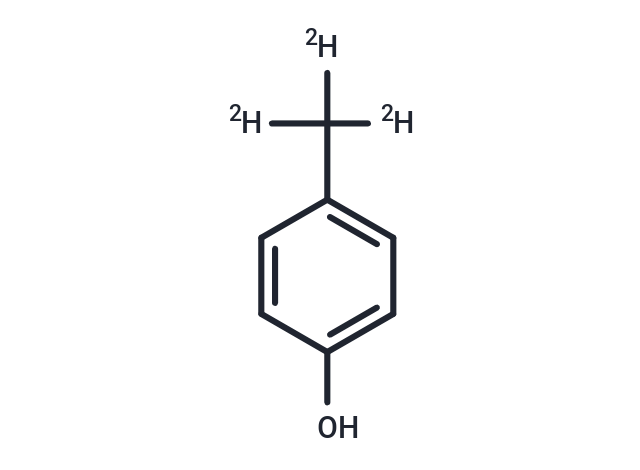- Remove All
 Your shopping cart is currently empty
Your shopping cart is currently empty
P-CRESOL-d3 (METHYL-d3)
P-CRESOL-d3 (METHYL-d3) is a deuterated compound of P-CRESOL. P-CRESOL has a CAS number of 106-44-5. p-Cresol (4-methylphenol) is a partially lipophilic moiety which strongly binds to plasma protein (close to 100%) under normal conditions. p-Cresol is metabolized through conjugation, mainly sulphation and glucuronization, but removal of the unconjugated p-cresol is, at least in part, via the urine. Therefore it is not surprising that this compound, together with several other phenoles, is retained when the kidneys fail. P-Cresol is an end-product of protein breakdown, and an increase of the nutritional protein load in healthy individuals results in enhanced generation and urinary excretion. The serum p-cresol concentration in uremic patients can be decreased by changing to a low-protein diet. p-Cresol is one of the metabolites of the amino acid tyrosine, and to a certain extent also of phenylalanine, which are converted to 4-hydroxyphenylacetic acid by intestinal bacteria, before being decarboxylated to p-cresol (putrefaction).

P-CRESOL-d3 (METHYL-d3)
| Pack Size | Price | Availability | Quantity |
|---|---|---|---|
| 1 mg | Inquiry | 20 days | |
| 5 mg | Inquiry | 20 days |
Product Introduction
| Description | P-CRESOL-d3 (METHYL-d3) is a deuterated compound of P-CRESOL. P-CRESOL has a CAS number of 106-44-5. p-Cresol (4-methylphenol) is a partially lipophilic moiety which strongly binds to plasma protein (close to 100%) under normal conditions. p-Cresol is metabolized through conjugation, mainly sulphation and glucuronization, but removal of the unconjugated p-cresol is, at least in part, via the urine. Therefore it is not surprising that this compound, together with several other phenoles, is retained when the kidneys fail. P-Cresol is an end-product of protein breakdown, and an increase of the nutritional protein load in healthy individuals results in enhanced generation and urinary excretion. The serum p-cresol concentration in uremic patients can be decreased by changing to a low-protein diet. p-Cresol is one of the metabolites of the amino acid tyrosine, and to a certain extent also of phenylalanine, which are converted to 4-hydroxyphenylacetic acid by intestinal bacteria, before being decarboxylated to p-cresol (putrefaction). |
| Molecular Weight | 111.16 |
| Formula | C7D3H5O |
| Cas No. | 108561-00-8 |
| Storage | Powder: -20°C for 3 years | In solvent: -80°C for 1 year | Shipping with blue ice. |
Sci Citations
Calculator
In Vivo Formulation Calculator (Clear solution)
Dose Conversion
Tech Support

Copyright © 2015-2025 TargetMol Chemicals Inc. All Rights Reserved.




